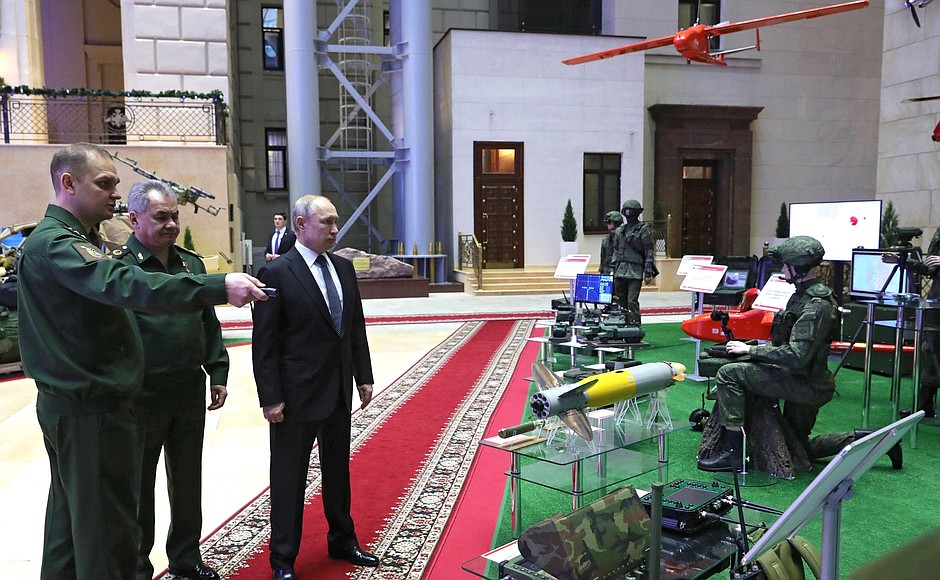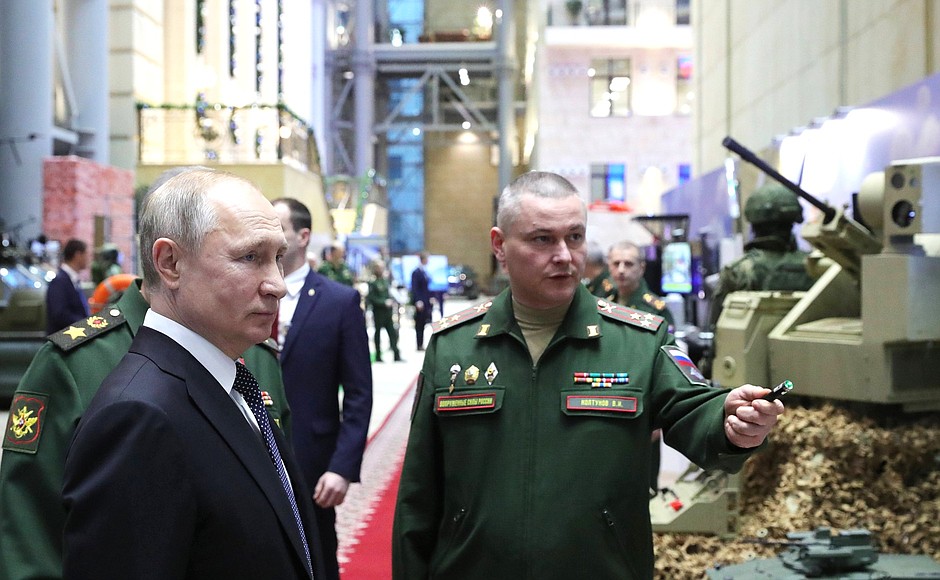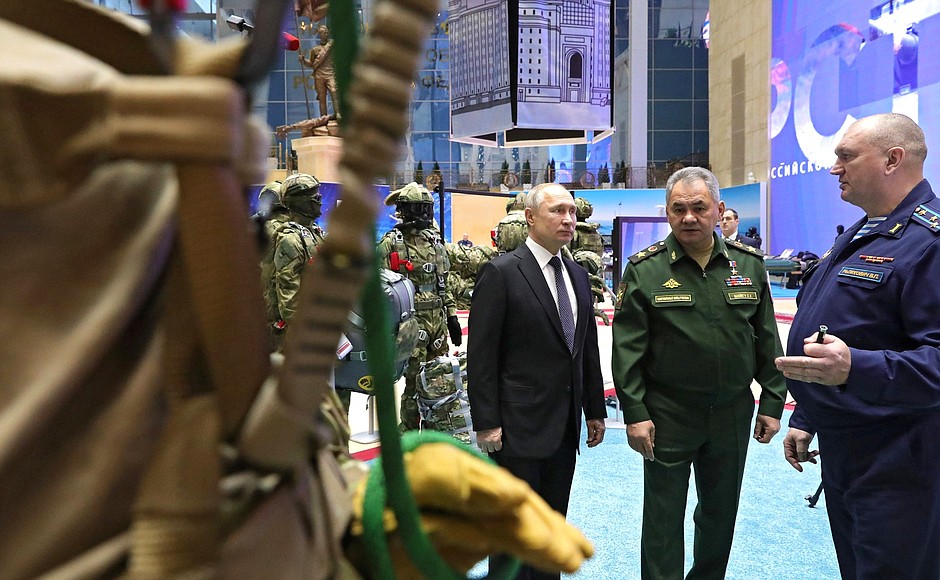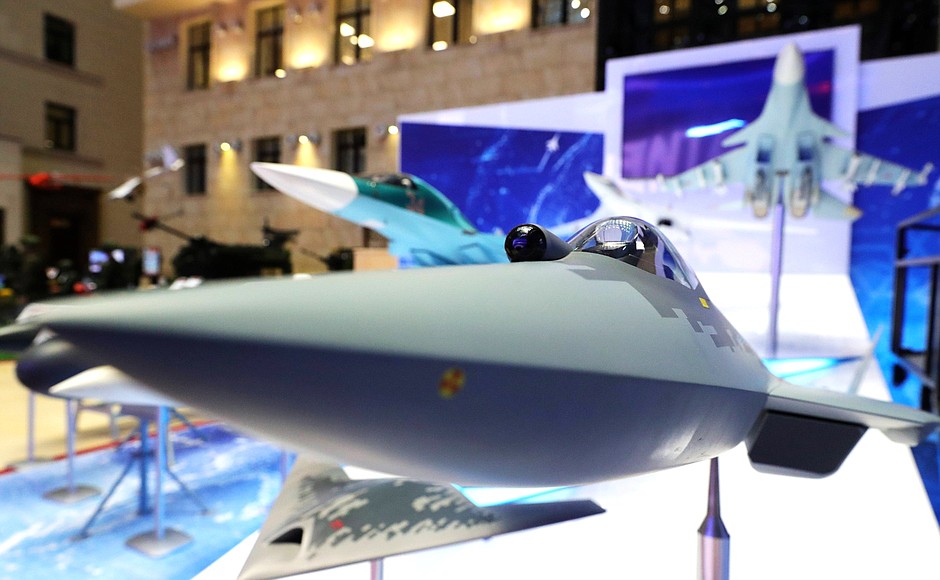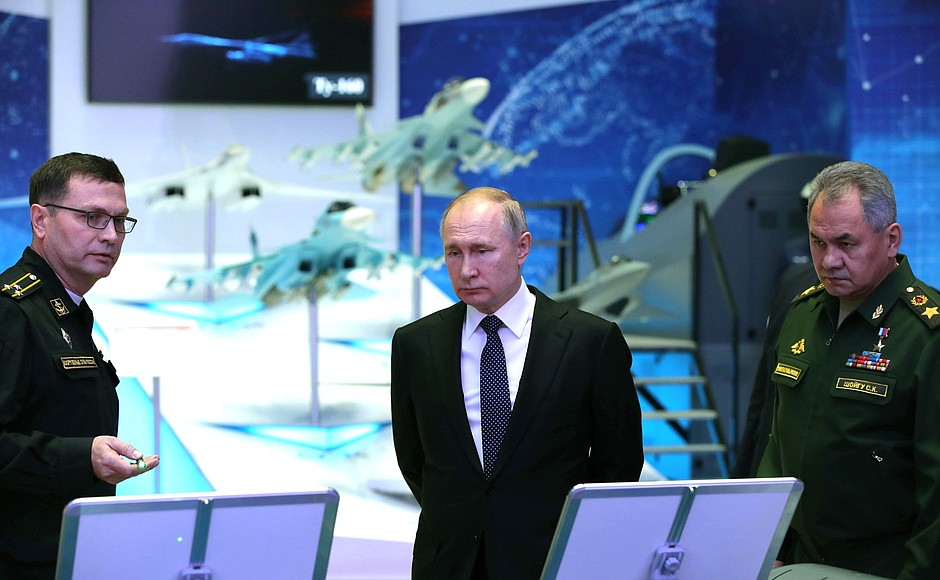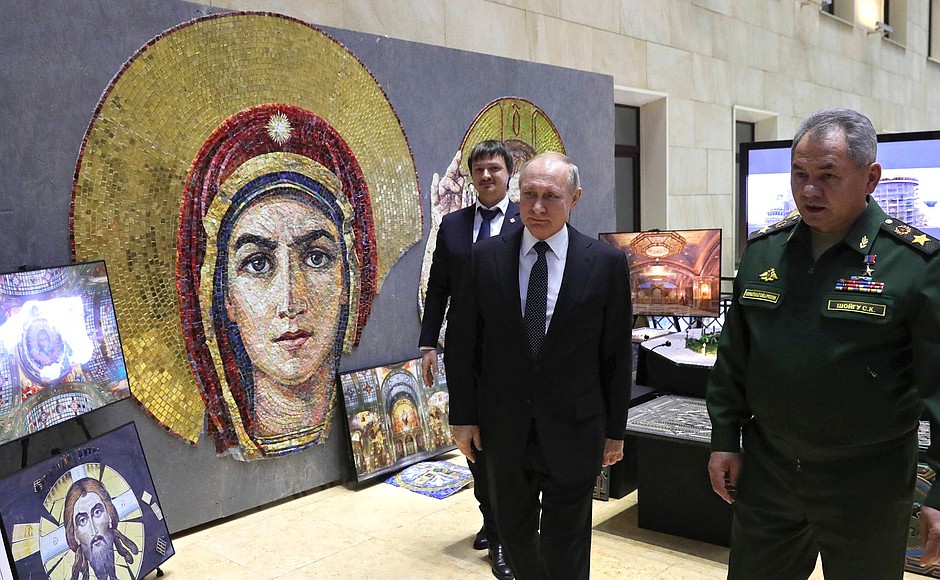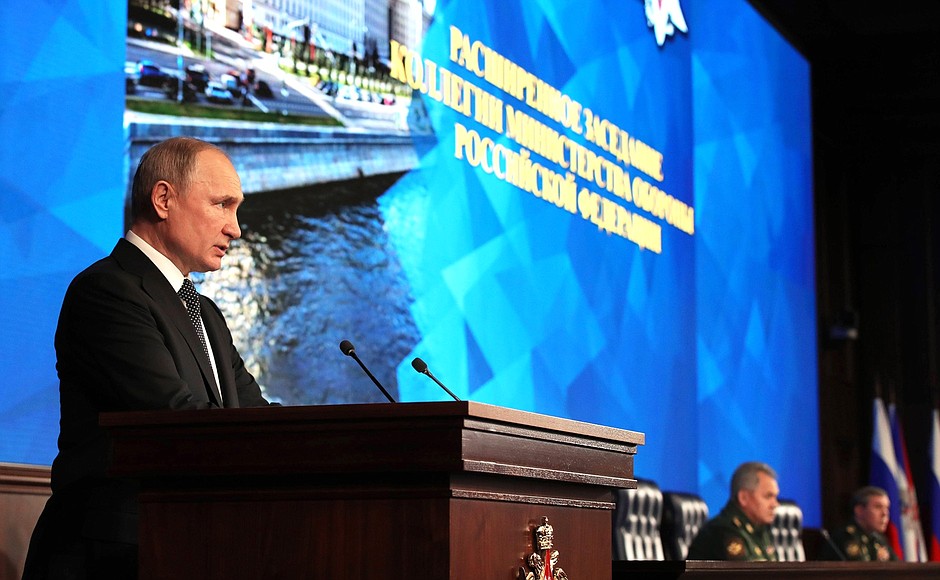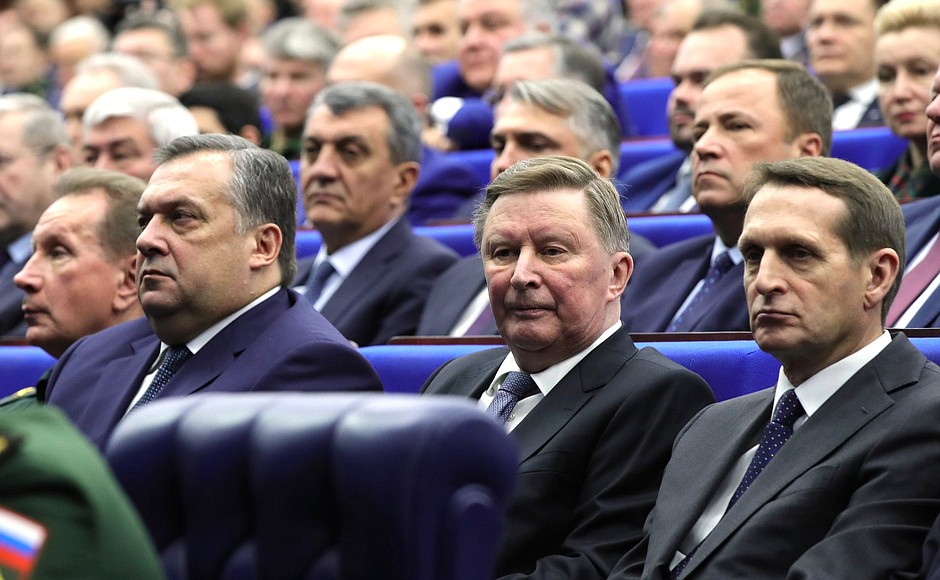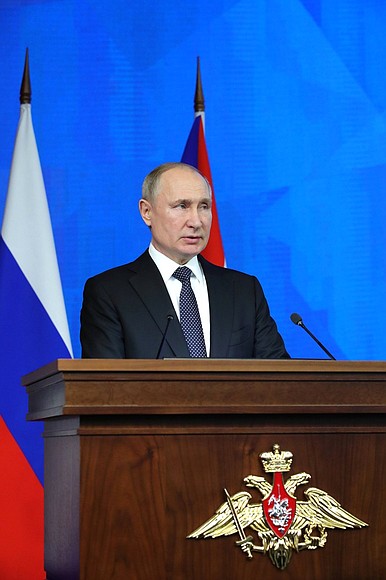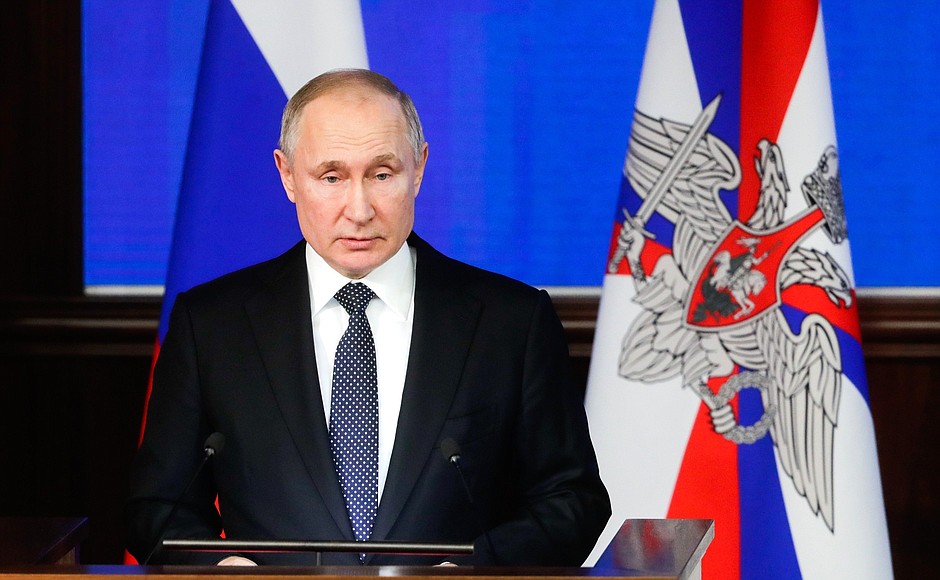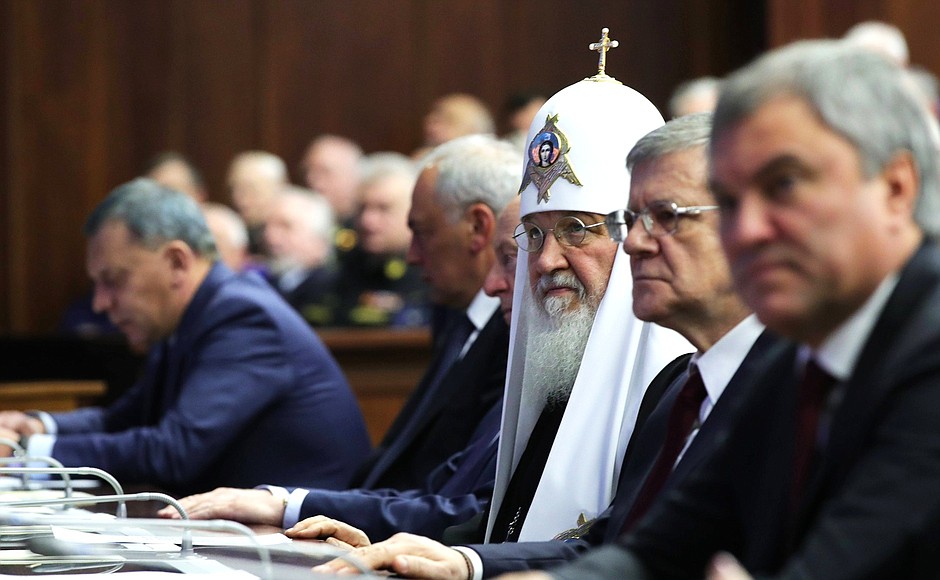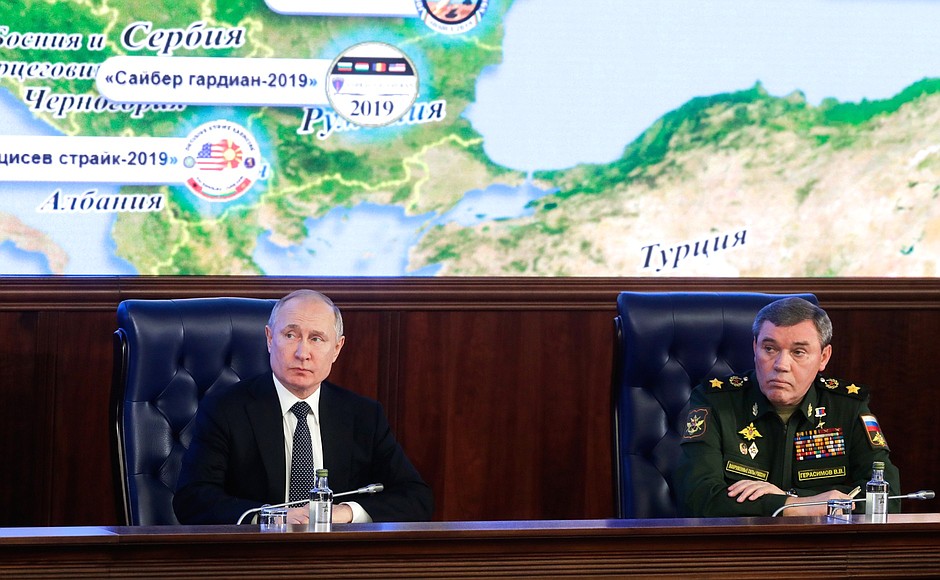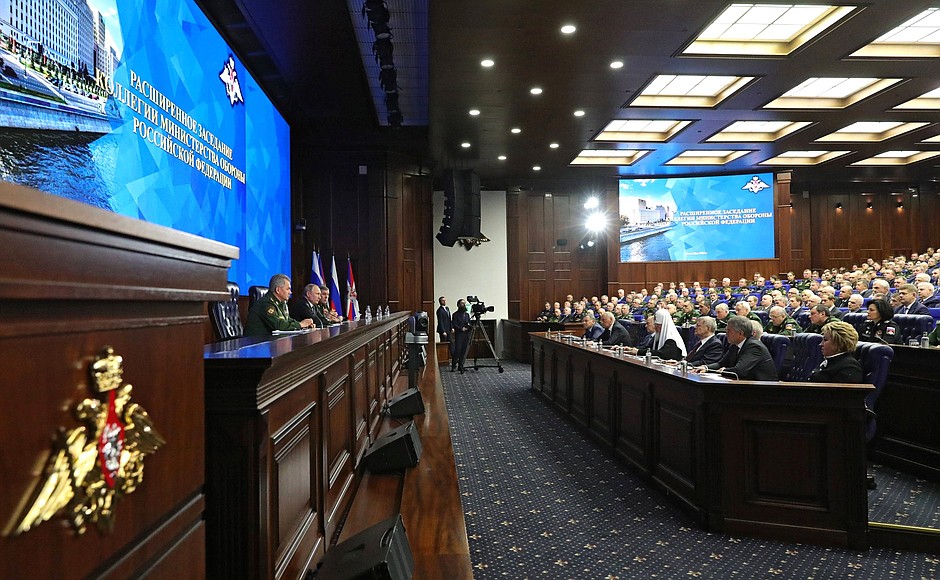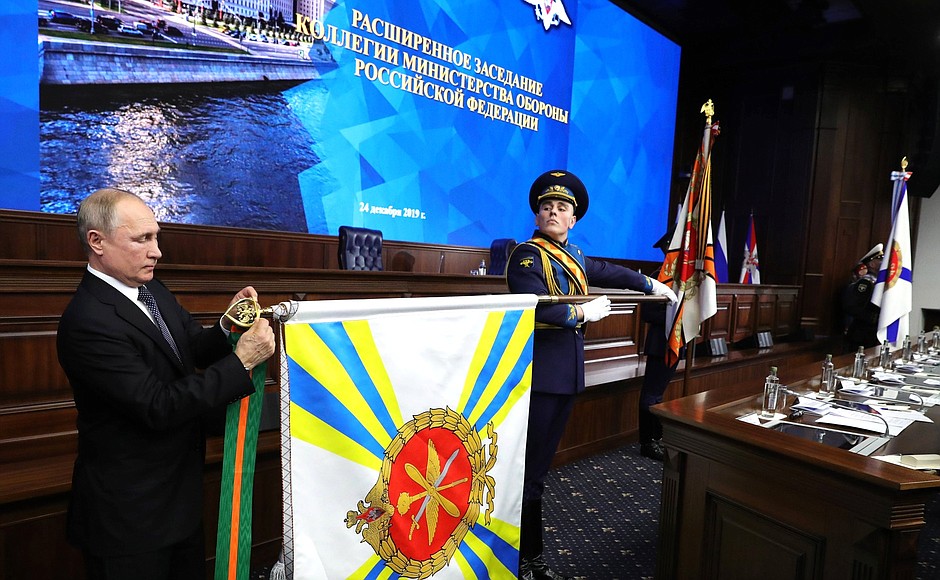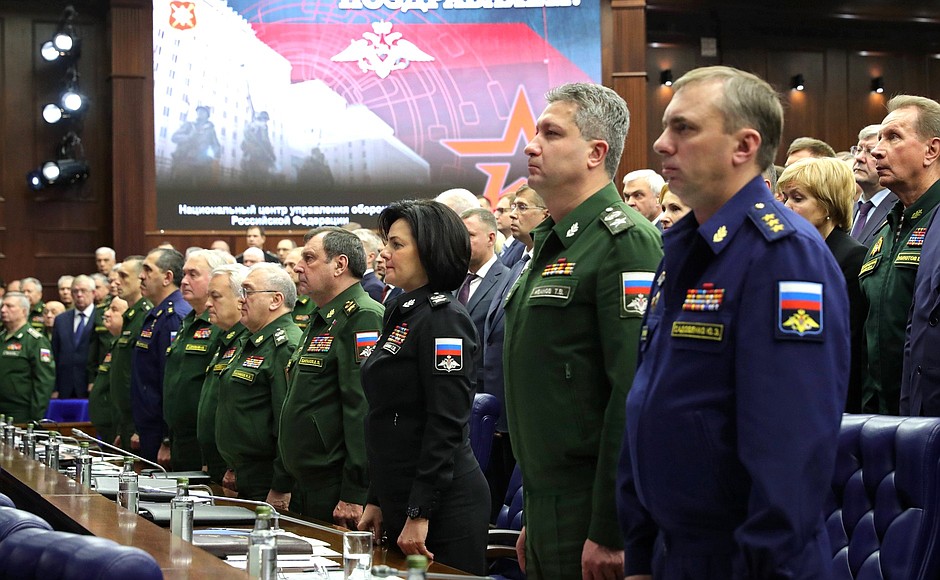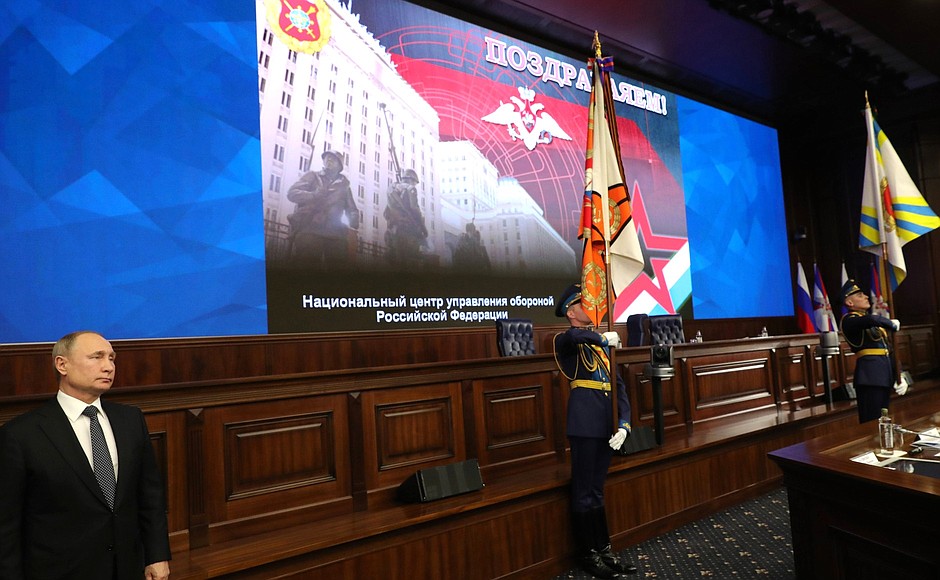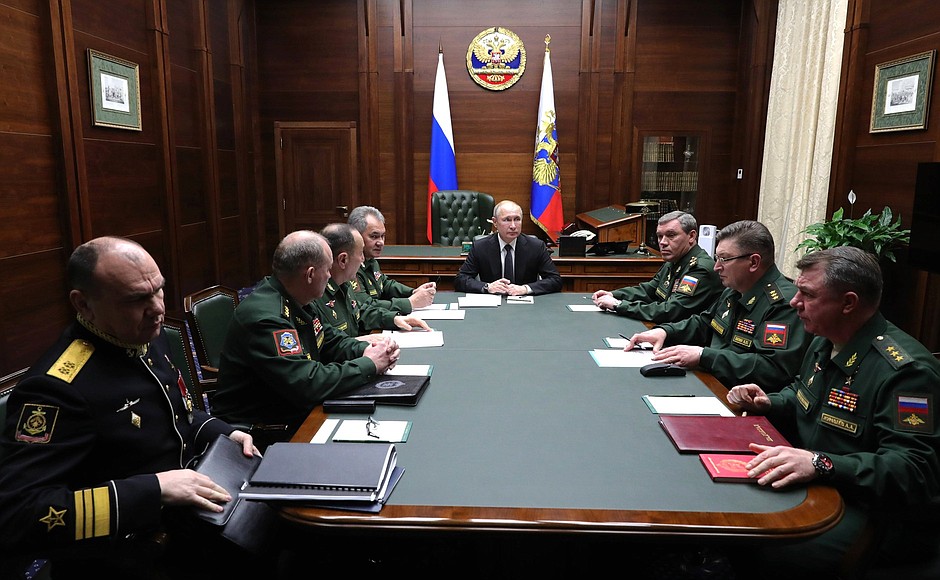The participants summed up the Armed Forces’ performance in 2019. The Supreme Commander-in-Chief outlined the principal objectives in terms of military development and in key areas of the Ministry’s activity next year.
The annual expanded meeting of the Defence Ministry Board was attended by members of the Security Council, senior members of the Federal Assembly and the Government, as well as commanders of military districts, formations and units of the Armed Forces.
After the meeting, Vladimir Putin awarded state decorations to the Northern Fleet, the Long-Range Aviation Command and the 104th Guards Air Assault Regiment. For strengthening the country's defence capability, high performance in combat training, courage and dedication displayed by the personnel during the implementation of combat training and special tasks the Red Banner Northern Fleet was awarded the Order of Ushakov; the Long-Range Aviation Command – the Order of Suvorov; the 104th Red Banner Guards Air Assault Regiment – the Order of Kutuzov.
During his visit to the National Defence Control Centre, the President also met with the commanders of the military districts and the Northern Fleet.
Before the meeting, the President visited an exhibition of advanced weapons and equipment. In particular, the President was shown the mortar (artillery) battery automation facilities set, the Adjutant complex, the Epokha unmanned combat module, the Harpoon-2M portable anti-drone system, a Russian-made buggy, the Phoenix UAV, the Piranha inflatable airboat and the latest Topaz, Taktika and Kalan armoured vests.
Vladimir Putin was also shown finds from the joint expedition of the Northern Fleet and the Russian Geographical Society carried out in August-September 2019 on Franz Josef Land. During the expedition, five new geographic locations were discovered and the maximum depth of the Barents Sea was specified at 634 metres. An explorers’ dog-sledge, one of the main finds, will be given to the Russian Arctic National Park in Arkhangelsk.
* * *
Speech at the expanded meeting of the Defence Ministry Board
President of Russia Vladimir Putin: Good afternoon, comrade officers,
Over the past few years, we have held the expanded meetings of the Defence Ministry Board and other events in the field of military development at the National Defence Control Centre. It opened on December 19 five years ago. Since then, it has become an effective instrument of army and navy command and a vital part of interagency cooperation.
I would like to thank everyone serving or working at the centre and those who created it, and to wish you every success in protecting Russia’s military security.
We have met for this expanded meeting to review the performance of the Armed Forces in 2019 and to discuss their principal objectives in the future.
It should be said that many quality and system-wide changes took place in the Armed Forces in 2019. The share of modern weapons in the nuclear triad has reached 82 percent. The latest ballistic missiles with the Avangard hypersonic glide vehicle (HGV) are being delivered to the Strategic Missile Forces. This weapon of the future can penetrate both the existing and any future missile defence systems.
Important steps have been taken to improve control, communications, intelligence and electronic warfare systems. The progress is mainly due to the introduction of the most recent technologies in the collection, transmission and processing of information.
If you remember last year, we talked about the need to reduce decision-making time at all levels of the Armed Forces. We have achieved a result. Thanks to the use of advanced technologies, integrated solutions and new algorithms, it was possible to improve the performance and increase the capabilities of the Armed Forces command and control system.
The previous models of weapons and equipment used in the Aerospace Forces, Navy, and in other branches and services are being systematically replaced by modern ones, including those based on digital technology and artificial intelligence. Robotic systems and unmanned aerial vehicles are being rigorously introduced and used in combat training, which dramatically boosts the capabilities of armed units and subunits.
The troops regularly use the new equipment to practice performing tactically difficult, non-standard tasks during their exercises, manoeuvres, and snap combat readiness inspections. The nuclear forces have confidently showed their increased capabilities at the Grom [Thunder] 2019 exercise. The Navy as well as long-range aviation fully accomplished their tasks during the Ocean Shield drills; for the first time, Russian military units tested and coordinated actions among eight states to perform antiterrorist operations during the Center-2019 manoeuvres.
The Russian army continues to play a key role in achieving peace in Syria. The Aerospace Forces group, ships and submarines of the Navy, including those deployed at the Khmeimim airbase and the naval base in Tartus, are guarantors of peace and stability in that country.
It is also important that Russia, thanks to the qualitatively increased capabilities of the Armed Forces, is confidently entering a new level of international military cooperation. Several Tu-160 flights over the western part of the Indian Ocean were performed from airfields in South Africa. Russian crews joined forces with their Chinese counterparts on combat patrolling of the airspace over the East China Sea and the Sea of Japan, also for the first time.
Efforts to develop military education and pre-university training were also among the notable outcomes of this year. Two new state-of-the-art education institutions opened: the Kemerovo Presidential Cadet School and a branch of the Defence Ministry Girls’ Boarding School in St Petersburg.
I can add that all military academy graduates in 2019, over 14,000 officers in total, received positions in the military confirming to their profession. This means that the overall military education system in its current form satisfies the current and future needs of the Armed Forces, operates in a balanced and sound manner, training new generations of military professionals who will build the future of Russia’s Army and Navy.
Colleagues,
A general review of the Armed Forces shows that it demonstrates high operational efficiency. All services and branches within the Armed Forces can deliver on their objectives, guaranteeing peace and security for Russia. This is a matter of principle and has critical importance in today’s international environment and considering the related risks.
Tension persists in the Middle East, in Afghanistan and on the Korean Peninsula. NATO is expanding its military infrastructure close to our borders.
The arms control regime is disintegrating, which causes serious concern. This is not limited to the dismantling of the Treaty on the Elimination of Intermediate-Range and Shorter-Range Missiles (INF Treaty) by the United States under a pretext that is clearly far-fetched and absolutely groundless.
Since November 2019, Washington has been creating uncertainty regarding its engagement under the Treaty on Open Skies. The prospects of extending the New START are equally vague. And all this is taking place while the United States is expanding the capability of its global missile defence system. We see this, and we are aware of these developments.
In this context we must continue to strengthen and develop the Army and Navy, as well as to focus on the following key objectives in 2020.
First of all, the share of modern weapons and equipment in the Army and Navy must reach at least 70 percent by the end of 2020. This goal has been already achieved in some arms and services, but others must continue working, for example, the Ground Forces.
This goal – 70 percent of modern equipment – must be attained and subsequently maintained. As I mentioned, our goal is not a one-time rearmament, after which we can forget about the Army and Navy for decades. The Army and Navy must always have the best equipment and technology. Just now I visited an exhibition, where some people reported proudly that some of our equipment and technology are up to world standards. But in fact, as I have told our defence representatives more than once, it must be even better; our equipment must be better than the world’s best if we want to come out as the winners. This is not a game of chess where we can sometimes accept a tie. It concerns the military organisation of the nation. Our equipment must be better. We can do it and we are doing it in the key spheres. But we must also do it in all spheres.
Second, the drafting of the national defence plan for 2021–2025 will be completed next year. While working on it, we must take into account the military and political changes that have happened in the world and try to forecast future developments, as well as to comprehensively analyse potential military threats and formulate measures for the use and improvement of the Armed Forces.
Third, I have said that this year the United States has actually destroyed the INF Treaty, which is why we must monitor the potential deployment of US missiles of this class around the world, but first of all in Europe and the Asia-Pacific region.
We are ready to work out new arms control agreements. But until this process is launched we will continue to strengthen our nuclear forces. I am referring to the delivery of cutting-edge Avangard and Yars systems to the Strategic Missile Forces and Borei-A missile submarines to the naval nuclear forces.
And lastly, we will continue to create other promising missile systems that can ensure guaranteed deterrence of aggression against Russia and its allies.
Fourth, operational and combat training should serve to develop innovative and more effective ways of using troops, units and subunits, and positive results should be immediately incorporated into combat training programmes.
During the upcoming Caucasus 2020 exercise, special attention should be paid to the training of command post staff to lead coalition forces and troops, and drill military personnel in acting in difficult geographical and climatic conditions.
Comrades,
One of our key and traditional priorities is to improve the social security system for military service members. The federal budget provides for their service pay to be indexed annually over the next three years: by 3 percent in 2020, and by 4 percent each in 2021 and 2022. Pensions of retired servicemen will also increase.
It is planned to continue issuing housing subsidies, requested by more than 70 percent of servicemen who are in need of housing. More than 218 billion rubles have been allocated for these purposes since 2014. In the next three years, another 113 billion will be provided. The development of a funded mortgage system will also continue.
It is important to continue to develop, in a balanced manner, all the components of the social security system for military personnel, as the effectiveness of your work – our common work on the Armed Forces development – will directly depend on this.
Colleagues,
Ensuring Russia’s defence capability is a crucial task and a priority among other matters of state and national importance. No matter how events develop, reliable and guaranteed defence of our Fatherland from any potential military threats must remain a given.
We do not forget the lessons of history; we are proud of our heroes and remember our fallen fighters. In the coming year, 2020, we will mark the 75th anniversary of the Great Victory in the Great Patriotic War with grand celebrations on a national scale. This day is sacred for all citizens of Russia – a symbol of courage and heroism of our Army, Navy, and all Russian people.
I know that the Armed Forces’ main cathedral, the Church of the Resurrection in Kubinka, is going to be completed in the Moscow Region in time for the occasion – I just got updated on the project. The Victory Parade on Red Square and a number of other grandiose events are being prepared. I am sure that all of them will be held at a high level, and the Armed Forces will celebrate the 75th anniversary of the Great Victory by showing even higher performance results in ensuring the nation’s defence capability and security.
I would like to thank you, colleagues, all the personnel of the Armed Forces, for the impeccable fulfilment of your tasks, and for your loyalty to Russia. I wish you success in your service.
Thank you.
Defence Minister Sergei Shoigu: Supreme Commander-in-Chief,
The military and political situation this year was characterised by the further building up of military capability. In 2020, the US military budget will reach almost $750 billion for the first time. This is almost equal to the total annual military budget of all the countries in the world and is 16 times larger than the Russian military budget.
NATO is implementing the Four for 30 anti-Russian initiative of the US, which envisages having 30 motorised battalions, 30 air squadron and 30 military ships ready in 30 days. As of December 1, the land component is completely set, the air component stands at 76 percent and the naval at 93 percent. According to our estimates, this concept can be fully implemented by 2022. It is expected that nuclear weapon carrier preparation times will be cut from 10 days to 24 hours.
US aircraft control and warning groups are deployed in the Baltics, which will allow controlling our air space as far as 450 kilometres in.
Every year the NATO bloc in Europe holds up to 40 large military exercises, which are clearly anti-Russian in nature. The intensity of air and naval intelligence near our borders has increased 33 and 24 percent, respectively, compared to last year.
The tests of intermediate range missiles carried out by the Pentagon in August and December confirm that the US is working on missile systems that were prohibited under the INF Treaty when it was in effect. The deployment of such systems in Europe and in the East will be the next logical step. The US is also not clear about the future of New START and the Treaty on Open Skies.
Without dragging ourselves in an arms race but with due regard to these threats, the Defence Ministry and the defence industry have continued to fulfil the reequipment of the Armed Forces and improving their quality.
Reequipping the Army and Navy. All Defence Ministry Action Plan items and the state defence order for 2019 have been fulfilled. We have achieved the highest rate of weapon and vehicle deliveries in the past four years. Providing the army with over 6,500 units of new and upgraded weapons increased the share of modern weaponry to 68.2 percent.
The Presidential instruction to equip the Strategic Nuclear Forces with fundamentally new strike systems is being fulfilled. The upgrade level for the Strategic Missile Forces is over 76 percent and is at 82 percent for the “nuclear triad.”
This week, the first missile regiment armed with the Avangard hypersonic glide vehicles will enter combat duty. Three more missile regiments were reequipped with the Yars road-mobile missile systems. The deployment of the Peresvet laser systems has been completed. Since December 1 they have been in service in missile deployment areas of five missile divisions of the Strategic Missile Forces.
The Strategic Nuclear Aviation acquired five upgraded missile carriers. Tests of the Knyaz Vladimir ballistic missile submarine and lead ship of the Borei-A class have been successfully completed.
This year, the Armed Forces received 624 tanks and other armoured vehicles, 143 modern planes and helicopters, 13 spacecraft, one submarine, eight surface ships, 17 boats and support ships, four Bal and Bastion coastal missile systems, and more than 10,000 units of modern communication technology.
Extensive work to reequip all Ground Forces’ missile brigades with Iskander systems has been completed. The third Kupol spacecraft for the Unified Space System was launched. The system is successfully fulfilling test and combat alert missions.
Practical test flights of the Okhotnik UAV, experimental long-range drone for reconnaissance and combat strike purposes, which surpasses its foreign counterparts, have been completed. On December 1, a unique over-the-horizon radar station went online. It is able to identify mass airborne aviation units and cruise missile launches, including hypersonic.
Long-term contracts were signed to deliver 76 Sukhoi Su-57 fighter jets and over 200 modern combat helicopters to the Aerospace Forces, and this allowed us to reduce purchase prices by 20 percent and ensure workload for defence industry enterprises until 2028.
For the first time in Russia’s modern history, 22 open ocean vessels are being built simultaneously for the Navy. Five ships were laid down this year, and eight more will be laid down next year. Efforts are being made to build them faster and equip them with high-precision weapons, including Zircon hypersonic missiles.
Mi-28NM helicopters, attack version of the Inokhodets (Ambler) UAV, and new versions of missile and bomb weapons for the Su-57 fighter jet were tested in battle in Syria.
Reequipping the Army and Navy, along with periodic servicing of military equipment, made it possible to increase the level of technical operability in the Armed Forces to 95 percent. At the same time, there is a problem with operational readiness of training aircraft which is currently 58 percent, and 56 percent for Yak-130 aircraft. We are working actively to improve the situation.
The transfer of 107 repair facilities to the defence industry and Rostec state corporation was completed in full.
Brand new technology and weapons developed in the Era military innovative technopolis are already being used in daily military activities. Four research and production companies have proven their efficiency. We consider it necessary to spread this practice to all defence industry enterprises.
Service personnel from 17 scientific companies are engaged in unique research in the defence sector. They have implemented 1,584 designs and registered 135 inventions. Having finished their service, 912 of them have become officers or have been employed by defence industry enterprises.
Over the past five years that the National Defence Control Centre has been in operation, the aggregate productivity of its computing power has increased eight-fold, and the volume of stored protected data has grown by 16 times which makes it possible to manage all Armed Forces activities, from everyday operation to combat control. The centre also conducts round-the-clock monitoring of state defence order implementation.
To improve the efficiency of fulfilling state defence order as part of the Unified Information System of Payments under the State Defence Order, the results of financial and economic activities of the state defence order contractors are accounted for separately. This made it possible to cut accounts receivable by 2.5 times, lower the prices for weaponry and equipment, and increase deliveries to the troops.
Your decisions, Supreme Commander-in-Chief, on reequipping the Army and Navy, made at the meetings in Sochi, are being fulfilled without interruption. Models of weaponry and equipment have been specified, procurement prices have been lowered, and the Unified Information System to control the state defence order is up and running.
At the same time, Russia’s military budget has remained at the same level for several years compared with the constantly growing expenses of the US and other countries. If last year we had the seventh largest military spending among leading countries, this year we are eighth and next year it will be ninth.
At the same time, the speed of reequipping the Army, establishing advanced military infrastructure and the plans for the social protection of military personnel are maintained.
Now to increasing the troops’ readiness to perform their designated duties. The level of field, air and naval training of military personnel has increased. In total, over 18,500 exercises and drills of various levels have been held in the Armed Forces; the goal to increase the time spent in the air or at sea has been fulfilled; two snap complex inspections of combat readiness involving military districts, services and branches of the Armed Forces have been carried out.
The Centre 2019 strategic command-and-staff exercise was the largest military training effort, with military units from seven CSTO and SCO countries taking part.
The Navy carried out the Ocean Shield joint drills. The group demonstrated its ability to effectively fulfil tasks related to the protection of our national interests in the Baltic and North seas and in the north-eastern Atlantic Ocean.
Every year the interest of foreign countries in the International Army Games, which have become an important element of military training, is growing. Competitions and games have been held in ten countries featuring teams from 39 states, and for the first time in India, Uzbekistan and Mongolia.
In order to increase the level of military skill of troops and to hold the games, 82 ranges have been upgraded and 42 exercises with our foreign colleagues have been carried out over the period of five years. The Russian-Chinese drills Naval Interaction 2019 and the Russian-Indian drills Indra 2019 were the most significant.
We continue to form a professional army. Along with new technically sophisticated equipment, the number of service personnel that are trained to operate and use it is growing. And at the same time, fewer conscripts are needed.
This year all contract soldiers had to pass an evaluation which identified professionally unfit applicants who were then dismissed. We continue to raise the selection requirements and the level of competence for contract soldiers. Today, over 70 percent have a professional education. At the same time they are financially motivated and the conditions for service have improved.
In 2019, over 14,000 officers graduated from military academies and joined the military. This is the second full-scale graduation from our military academies. The system of military education has reached the required volume of training capacity and is capable of providing for the Army’s needs in terms of qualified military personnel.
The officer manning level has been raised to 95 percent with an average age of 35. The officer corps displays high morale and willpower, and professionalism. Combat experience was acquired by all commanders of the military districts, all-arms armies, the Air Force and the Air Defence armies, divisions, brigades and regiments, 90 percent of air forces personnel, 56 percent of air defence specialists, 61 percent of Navy officers, 98 percent of military police, and 78 percent of the engineering corps.
Competition among military academy applicants remains high. This year up to 18 applicants competed per one opening.
The electronic education environment is being developed: the number of basic e-manuals has increased threefold.
The decision to index the service pay, taken by the President of the Russian Federation, keeps it at the same level as in the leading industries. Also, military pensions will be indexed every year.
The task set by the Supreme Commander-in-Chief on ensuring kindergarten admissions and employing servicemen’s wives has been accomplished in full, like in the previous year: almost 5,000 children went to preschools, and over 900 wives have been employed. This issue remains a priority for us.
This year 15,500 patients received hi-tech medical treatment. The servicemen morbidity has fallen by 15 percent in the past three years whereas the most common medical condition – respiratory diseases – dropped by 23 percent. Service personnel in remote garrisons had 765 emergency and scheduled tele-medical consultations.
Troop installation. All installation activities scheduled for 2019 were fully carried out. The construction, renovation and overhaul of 3,750 buildings and facilities with a total area of 3.5 million square metres was completed. The infrastructure is being built simultaneously with the supply of arms and military vehicles. Seventy-five percent of all facilities are built under a standard design, which cuts build time in half and reduces the cost of design work.
In total, over 650 buildings and facilities have been built this year that are related to nuclear deterrence capability and personnel. The renovation of 19 airfields has been completed, with over 230 buildings and facilities put into operation.
In five years, two launch complexes for the Angara light and heavy rocket class were built at the Plesetsk Space Launch Centre, and the launch complex for the Soyuz-2 rocket was rebuilt. The first launches took place from the new launch centres this year.
The Caspian Flotilla facilities are currently under construction.
Military medical institutions have completed the construction of more than 100 buildings and facilities. The construction of military hospitals in Penza, Yuzhno-Sakhalinsk and Vladikavkaz are ongoing. Of the 140 medical institutions we need, 23 still remain to be built by 2030, including nine that will be completed next year.
The programme for creating a network of presidential cadet schools has been fully implemented. The final stage was the opening of an educational institution in Kemerovo this year, and a branch of the Defence Ministry Boarding School for Girls opened in St Petersburg.
Next year, we will open a Nakhimov Naval School branch in Kaliningrad, thereby completing the development of this network of branches.
A sports centre at the Ussuriysk Suvorov Military School and an ice palace at the Nakhimov Naval School are now in operation. In total, the Armed Forces have over 50 ice rinks and the same number of swimming pools. In total, we need 55 pools, and four are to be built by 2025. We will achieve the same performance for ice rinks.
As for providing homes for military personnel, we have delivered in full on the permanent home plan. This year, 7,000 military personnel received permanent homes, including 1,900 who were given flats and 5,100 who received housing subsidies. In 2019, about 600 military personnel moved into corporate housing every week. Overall, housing was provided to over 33,000 families.
The specialised housing inventory includes over 41,000 residential premises. Given that the compensation for sublet housing was increased to the real amount paid in rent, there was a decline in demand for new corporate flats and, accordingly, a reduction in maintenance expenses. In addition, families of military personnel have moved into 17,000 flats that were returned to the housing inventory by judicial decision.
The savings and mortgage system has attracted 300,000 military personnel, including about 110,000 who have already purchased permanent housing in the location of their choice.
A solution has been found to the long-standing problem of military personnel who are not included on the staff until they are provided with homes. All social obligations owed to them have been met in full. I would like to remind you that the number of this category of military personnel has declined to a mere 47 from about 61,000 five years ago.
The commissioning of the first NARA integrated industrial and logistics enterprise will allow us to shut down all economically unviable and outdated depots and warehouses.
Thanks to private investment, the construction of an integrated industrial and logistics enterprise has begun in Arkhangelsk and next year we will launch this project in Sevastopol and Vladivostok.
All missiles and ammunition at 79 storage facilities located within the boundaries of populated areas and near hazardous industrial facilities have been relocated to new modern storage facilities.
Oil companies have built 12 fuelling stations on Armed Forces’ airfields with their own funds. The construction of another five stations is underway. Oil company investment totalled 18 billion roubles. In 2020, they will invest another 3 billion roubles.
The Defence Ministry has partnered with the Presidential Executive Office to address the issue of creating five rail teams, without attracting Armed Forces personnel, to carry out the Supreme Commander’s instruction to build a second line on the Baikal-Amur Railway from Tynda to Komsomolsk-on-Amur.
Development of the military infrastructure continues in the Arctic. In total, 590 facilities with a total area of over 720,000 square metres were built using innovative technology. Top priority military settlement facilities with a total area of 4,600 square metres were built in Tiksi to accommodate the Northern Fleet air defense divisions. The Nagurskoye military settlement was completed on the island of Alexandra Land. A school for the children of military families was renovated in the village of Belushya Guba, Novaya Zemlya Archipelago.
Environmental recovery measures were completed in the Arctic military deployment areas a year ahead of schedule. Over 113,000 square kilometres were cleaned; 23,000 tonnes of scrap metal were collected, and 18,600 tonnes were removed. On the Novaya Zemlya Archipelago, 453 buildings have been blasted.
Next year, environmental clean-up will continue at Cape Marre-Sale, Novaya Zemlya Archipelago, Kildin Island and Wrangel Island.
Implementation of the Effective Army programme continues. Over the past six years, we have reduced shortages of basic items of material, technical and utility support amid constantly growing prices of these services, which allowed us to fulfill the tasks assigned to the Defence Ministry. We consider it necessary to expand the Defence Ministry’s participation in national projects.
A systematic approach to preparations for the heating season allowed us to cut the number of malfunctions 6.5 times. In conjunction with Novatek and other commercial companies, we are implementing a pilot project to convert boilers to liquefied gas. The annual savings are expected to amount to 370 million rubles a year for four boiler plants alone. We transferred 32,000 facilities unclaimed by the Defence Ministry to the Russian regions, cutting our maintenance bill by 3.7 billion rubles.
Regarding missions abroad. To ensure a military presence in strategically important areas, strategic missile carriers ran 48 sorties this year. In July, Russian and Chinese strategic bombers held the first patrolling mission in the Asia-Pacific Region. In October, the Tupolev Tu-160 strategic bombers used airfields in the Republic of South Africa. Russian Navy ships made 111 voyages to the Arctic zone, the Central and Northern Atlantic, the Caribbean basin and piracy-prone areas of the Gulf of Aden. Russian ships also took an active part in joint military drills in Southeast Asia and in the Indian Ocean.
Russian service personnel are guarantors of lasting peace in Syria. Russian Aerospace Forces craft average two to three sorties per day for reconnaissance and air support of Syrian Army actions to eliminate separate terrorist groups. Let me remind you that in 2015, our air force made 80–90 sorties per day while pursuing its mission.
Overall, we have tested 359 samples of modern weaponry in Syria. The service personnel at the Russian centre for reconciliation of the opposing sides in Syria conducted over 2,000 humanitarian missions. The military medics rendered aid to 109,000 civilians. The Syrian authorities, along with Russian military personnel, conduct a programme for restoring peaceful life and the return of refugees. In total, about 2 million refugees and internally displaced persons have returned to their places of residence since 2015.
Modern military and social infrastructure has been deployed in areas of Russian troop deployment in Syria. This year, protected shelters for semi-strategic aviation were opened at the Hmeimim airfield, whereas in Tartus a modern ship-repair facility was built.
Russian military facilities are reliably protected by air defence and electronic warfare systems. This year alone they downed 53 drones and 27 multiple launch rockets fired by terrorists.
Since 2015, Syrian air defence repelled 83 attacks of the US-led coalition and Israel as well as terrorist attacks whereby 217 cruise missiles, 38 guided bombs and 25 drones were destroyed
Unlike the Patriot systems in Saudi Arabia, the Russian air defences down at least 72 percent of high precision munitions and UFVs during each massive strike. Meanwhile, the Syrian air defence, alongside with modern Russian Pantsyr and Buk systems, is largely comprised of obsolete Soviet S-75, S-125 and S-200, which were repaired and upgraded by Russian specialists.
We are building a modern military and social infrastructure for service personnel and their families at Russian bases abroad.
This year, a battalion of S-300PS surface-to-air missiles with Russian crews was placed on combat duty at the training centre of the 201st Military Base in Tajikistan. The Armed Forces of Tajikistan will be able to obtain these systems in two years, when their specialists have been trained.
We prioritised military-technical cooperation with China, India, Egypt, Algeria and Vietnam. We continued to strengthen allied relations with countries of the Collective Security Treaty Organisation, the Commonwealth of Independent States and the Shanghai Cooperation Organisation.
The International Military-Technical Forum Army 2019 became an important event in expanding military-technical cooperation. The event surpassed the 2018 forum in terms of its main parameters. State contracts worth over one trillion rubles were signed. In five years, the forum has become the largest arms exhibition worldwide. A record-breaking number of delegates from 111 countries and seven international organisations attended the annual Moscow conference on international security.
Regarding military-political work, our military-political authorities, together with generals and commanders helped maintain high moral-psychological levels of the service personnel. We continue to establish and reinstate a system for training specialists for these authorities. Military-political authorities will address additional and more topical tasks.
The Defence Ministry spearheads the military-patriotic education of young people. Today, theYunarmiya [Young Army] Military Patriotic Movement encompasses all Russian regions and unites over 600,000 teenagers. Obviously, we need to improve the efficiency of regional Yunarmiya divisions. We consider it appropriate to suggest that regional leaders work more actively in this field.
As per the Supreme Commander in Chief’s instruction, we have started deploying Avangard training-methodological centres that will operate all year round. In 2020, they will be established and will start working in Moscow Region as well as in Moscow. The Nizhny Novgorod centre was established earlier in 2019. We are expecting all Russian regions to work actively.
The Main Cathedral of the Russian Armed Forces will be consecrated and opened in the run-up to the 75th anniversary of the Great Victory. The memory of 33 million people who took part in the Great Patriotic War will be perpetrated for the first time in world history at the Road of Memory museum complex; surviving photos and wartime letters will also be on display there.
There are plans to launch the six-route Echelons of Victory mobile patriotic project in military districts and at the Northern Fleet.
On Victory Day, we will hold military parades in 28 cities, as well as official events involving service personnel in 447 communities. There are plans to have festive fireworks displays in 68 cities of the Russian Federation.
Comrade Supreme Commander-in-Chief, the Armed Forces have achieved all the goals that were set for 2019, increasing their combat capability by 14 percent and maintaining national defences at the required level. Some problems have been uncovered, and ways to deal with them have been added to the ministry’s plans for 2019–2025.
In 2020, the ministry will have several priorities: 22 launchers with Yars and Avangard ballistic missiles are to be put on combat duty at the Strategic Missile Forces; the modernisation of six Tu-95MS strategic bombers is to be completed; and the first of seven Borei-A class nuclear-powered submarine cruisers, Knyaz Oleg, armed with Bulava ballistic missiles is to be delivered to the navy.
As for the general purpose forces, 565 modern armoured vehicles, 436 standard artillery systems and two battalions of the Buk-M3 air defence systems are to be delivered to the Army and the Coast Guard of the Navy, plus 11 new formations and military units are to be established.
The Aerospace Forces and the Navy will receive 106 new and modernised aircraft plus four regiments of the S-400 Triumf and six battalions of the Pantsir air defence missile systems. The fourth spacecraft of the Unified Space System is to be launched and the technical operability standards of aircraft are to be raised to 80 percent through the signing of state contracts regarding cost per flight hour and transition to an advanced system of aircraft maintenance support.
The Navy is to receive 14 surface ships and boats, three submarines, 18 auxiliary ships and boats and one Bal coastal defence system. The construction of infrastructure facilities for strategic submarines is to be completed on the Northern and Pacific fleets; a project-oriented system of designing, building and modernising naval ships will be introduced; and the share of modern weapons and equipment in the Armed Forces will be increased to 70 percent, as per the instructions set out in the May 2012 Presidential Executive Orders. We will maintain the operability of weapon systems and equipment at the current level, hold 19,200 exercises and drills, including the Caucasus 2020 command post exercises, and make sure that 3,200 buildings are ready by the time the planned delivery of weapons and equipment takes place, as well as continue to implement the Effective Army programme.
Comrade Supreme Commander-in-Chief, as per your instructions, we will continue the progressive development of the Armed Forces and enhance their quality standards next year. We will speak about the details during the restricted part of this meeting.
This concludes my report.
Thank you.
Vladimir Putin: Colleagues,
In conclusion, I would like to say a few words about issues not directly related to the topics we discuss today but concerning them in one way or another.
Let me begin with a story. You may have noticed that recently I met with my colleagues, the CIS heads of state – the heads of the countries that not so long ago were part of our common motherland, our common state, which faced Nazi Germany in World War II and won the Great Patriotic War.
I said there (and we have noted this many times) that some countries – our neighbours in Europe and on the other side of the ocean – often try to distort history and make up unbelievable scenarios of how the situation in the world and Europe developed on the eve of World War II. And recently, as a logical conclusion to this process, the European Parliament adopted a resolution that almost puts Nazi Germany and the Soviet Union on the same level, implying or even saying directly that the Soviet Union was also responsible for the beginning of World War II. Of course, this is complete nonsense.
I asked my colleagues to search for some materials in the archives and I looked them through. I presented an incomplete list of those documents to my colleagues who are present here today, and to the CIS heads of state. I mentioned this in passing at that meeting, we had no time really, and even now there’s no occasion yet to talk about it in detail. Nevertheless, I will still talk a bit about it, and later, as you might have noticed, I will write an article on this, just as I promised.
The USSR was the last country in Europe to sign the Treaty of Non-aggression with Germany. The last. All the other leading European countries did this before the Soviet Union. Yes, the Molotov–Ribbentrop Pact (let me remind you that Ribbentrop was Germany’s foreign minister, and Molotov was the foreign minister and chairman of the Council of Ministers) was signed, and there was also a secret protocol which defined the spheres of influence. But what have the European countries been doing before that? The same. They had all done the same thing, starting in 1938, when Hitler claimed part of Czechoslovakia, and Great Britain and France turned their backs on their ally, although France had a treaty of mutual assistance with Czechoslovakia. Thus Hitler got a chance to seize part of the country.
But what did the other countries do, Poland, for example? They actually conspired with Hitler. This much is directly evident from the documents – from archive documents. Another question is whether there were any secret annexes or not – but it doesn’t matter. It is important how they acted. They acted in collusion for certain – just from the documents on how they negotiated. And at the so-called Munich Conference, Hitler directly represented the interests of Poland, and partly of Hungary. He directly represented their interests, and then he said to the Poles: It was so difficult to defend your interests, you know. We have it all in the documents. Thank God, we have enough archival documents that we attained as trophies from the European countries after World War II.
But that’s not all. What really hit me hard, I’m telling you honestly, was how Hitler and the official representatives of Poland discussed the so-called Jewish problem. Hitler told the Minister of Foreign Affairs, and later bluntly said to the Polish Ambassador to Germany that he had a plan to send the Jewish population to Africa, to the colonies. Imagine, in 1938, to expel Jews from Europe to Africa. Sending them to their extermination. To destruction. And here is what the Polish ambassador wrote to the Polish Foreign Minister, Mr Beck: When I heard this, he wrote, I responded (to Hitler, he means), that if this happens and this issue is resolved, we will build a beautiful monument to him (to Hitler) in Warsaw. That bastard! That anti-Semitic pig – I have no other words. He was in complete solidarity with Hitler in his anti-Jewish, anti-Semitic sentiment and, moreover, he proposed erecting a monument to Hitler in Warsaw for persecuting the Jewish people. And he wrote to his patron, the Minister of Foreign Affairs, apparently hoping for understanding and approval. He would not have written this without a reason.
I won’t go into more detail now, but in any case, I want to emphasise again: we have enough materials to prevent anyone from corrupting the memory of our fathers, our grandfathers, and all those who gave their lives for the victory over Nazism.
I just want to note that this kind of people, people like the ones who were negotiating with Hitler back then, they now deface monuments to the liberator soldiers, Red Army soldiers who liberated the countries of Europe and the European peoples from Nazism. These are their followers. In this sense, unfortunately, little has changed. And we must keep this in mind, also with regard to the development of our Armed Forces.
Here is what I would like to say in this regard, which I think is critically important. Please note: neither the Soviet Union, nor Russia have ever tried to create a threat to other countries. We were always catching up in this regard. The United States created the atomic bomb, and the Soviet Union caught up with it. We did not have nuclear weapon delivery vehicles or carriers. There was no such thing as strategic aviation, and the Soviet Union was catching up in this area, as well. The first intercontinental missiles actually were not built here, and the Soviet Union was trying to catch up.
Today, we have a unique situation in our new and recent history. They try to catch up with us. Not a single country possesses hypersonic weapons, let alone continental-range hypersonic weapons. We already have Kinzhal (Dagger) hypersonic missile systems in the field, and Peresvet laser combat systems have already been deployed with the troops as well.
The Minister just told us that we have begun to equip the first regiment of the Strategic Missile Forces with the latest Avangard hypersonic glide vehicle. Work on other systems is underway, including Sarmat boosted intercontinental ballistic missile; Zircon ground- and sea-based hypersonic rockets; the Poseidon UUV; and the Burevestnik nuclear-armed cruise missile.
Other systems have been fielded as well, including the ones that were tested during various exercises and in combat conditions in Syria, such as Kalibr cruise missiles.
There are also other technologies. They are not covered much in the media, but they do exist, are sent to the army and are operational.
In this regard, I would like to say that even though we spend much less than other countries (we rank 7th at this point, the Minister said, and could even slide to the 9th), this does not mean that we are ready to compromise our combat readiness. No. All we are doing we are doing according to a plan.
At one of the board meetings I deliberately said, and maybe someone in the audience remembers it; I would like to repeat what I said back then. I didn’t say it accidentally. I said it because it represents our competitive advantage and it is about our ability to maintain the defence capability we need. What exactly will help us move forward? I said then literally the following: brains, intelligence, better organisation of work, minimising theft and negligence, and concentrating efforts on key areas will lead us to a high state of defence capability.
Please build your work in this way in the new year. Happy New Year! I wish you every success. Thank you.
